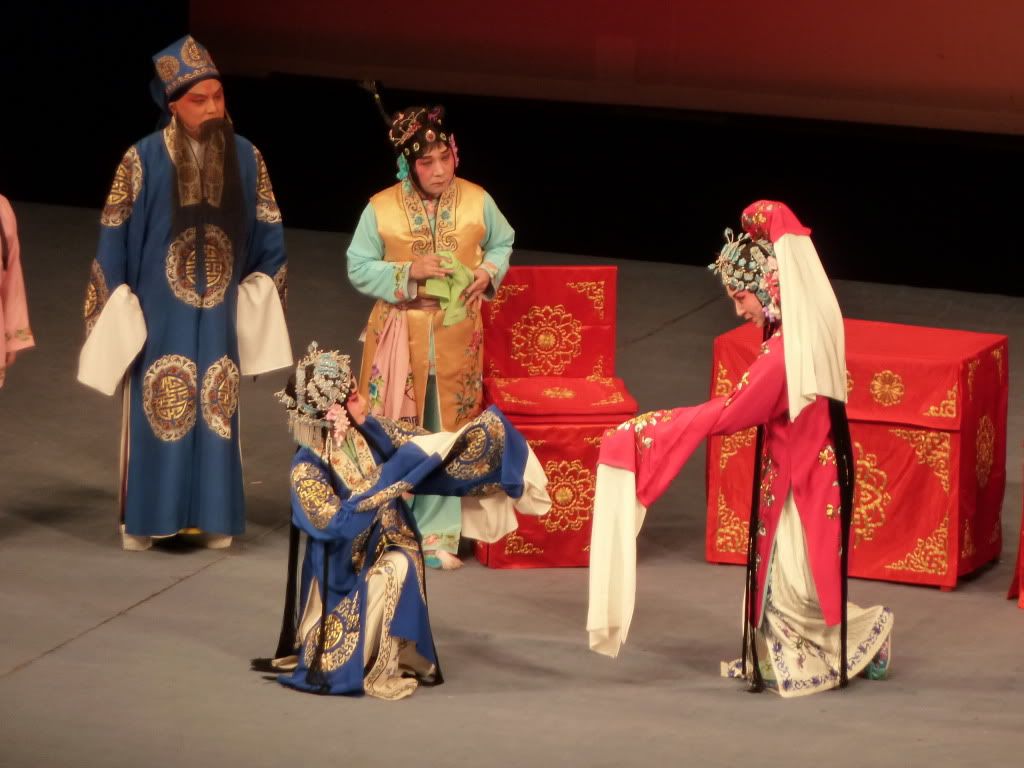
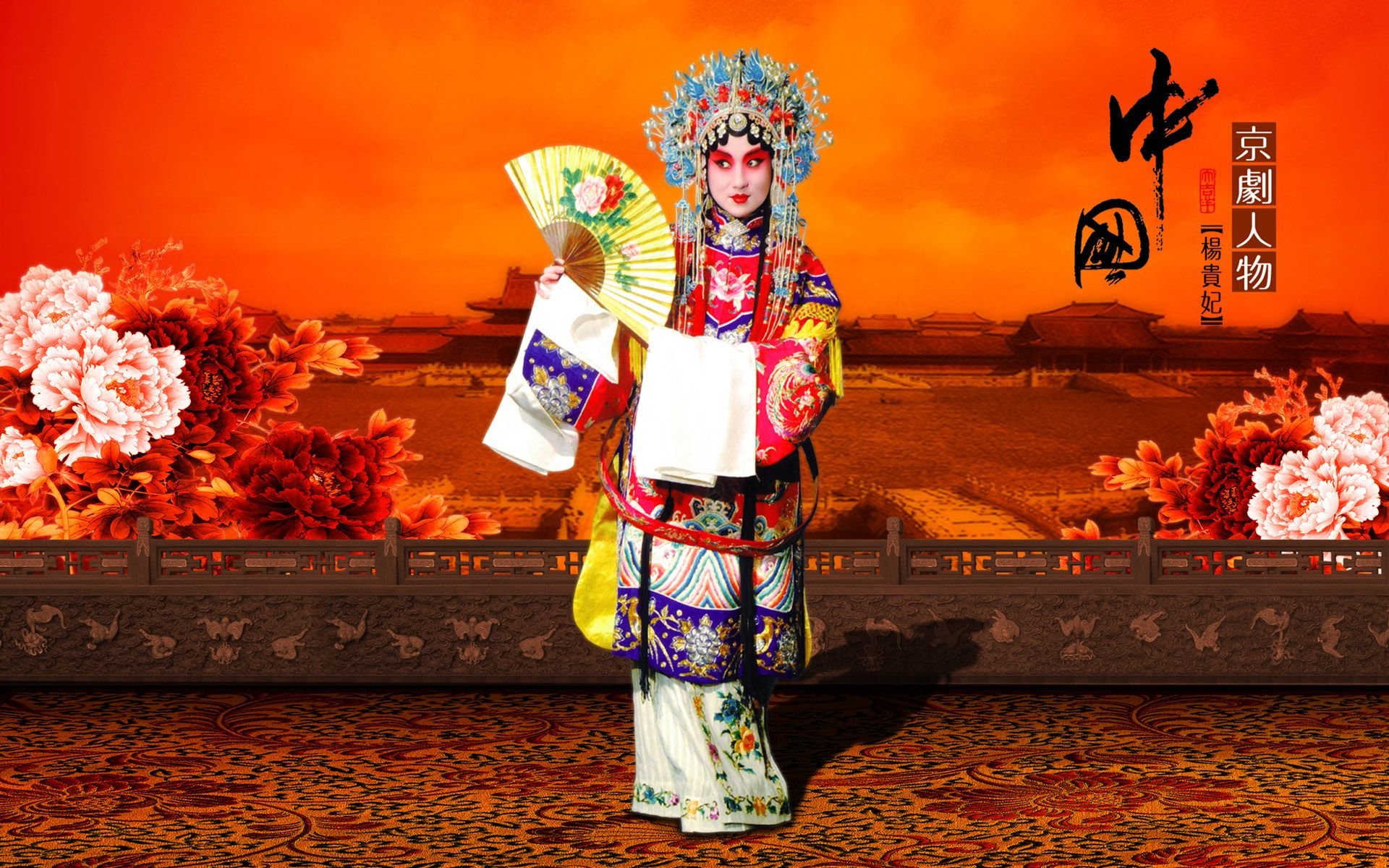
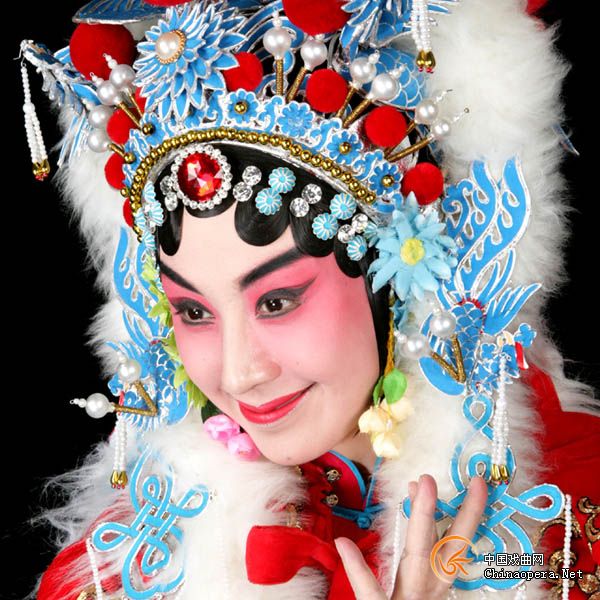
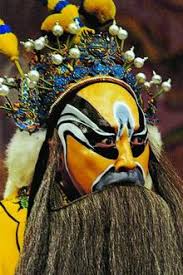
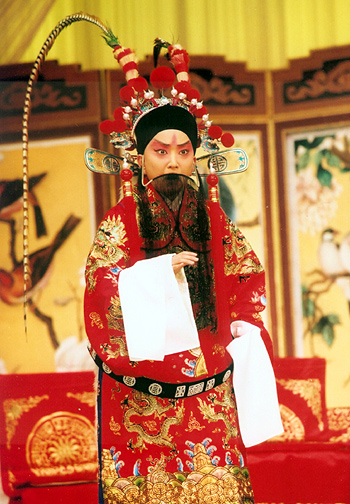
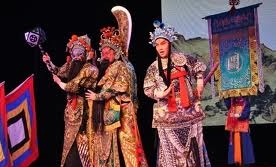
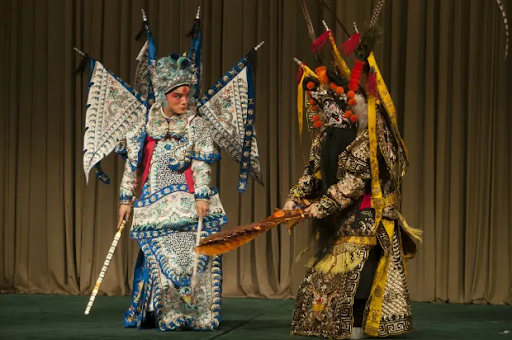
Die Peking-Oper (chinesisch 京劇 / 京剧, Pinyin Jīngjù) ist eine Form der chinesischen Oper. Sie vermischt viele künstlerische Elemente, so Singen, Tanzen, Akrobatik, darstellendes Spiel und Kampfkunst. Die Bühnenausstattung ist betont spärlich – ursprünglich besteht sie aus einem Tisch und zwei Stühlen. Im Allgemeinen arbeitet die Peking-Oper eher mit symbolischen als mit rein ästhetischen Mitteln. Im Gegensatz zu anderen Formen der chinesischen Oper handelt es sich nicht um eine regionale Spielart der Oper, sondern sie wird in ganz China von Theatergruppen aufgeführt.
2010 wurde die Peking-Oper in die Repräsentative Liste des immateriellen Kulturerbes der Menschheit der UNESCO aufgenommen.[1]
Die Peking Oper ist die waschecht Essenz chinesischer Kultur. Weil die Peking Oper sich in Beijing stark entwickelt hat, bekam sie den Namen, aber sie geht auf einige andere alte regionale Opern zurück, wie Kunqu, die Shaanxi Oper usw.. Während der 200 Jahre haben sich die Liedtexte, Musik und Melodie erneuert und so ist die Peking Oper nach und nach ein ausgereiftes Theater geworden, die mit Gesang, Tanz, Musik, Kunst und Literatur verbunden ist, weshalb sie auch die Ostoper genannt wurde. Etwas besonderes in der Peking Oper ist der Gesichtmaskentyp, durch deren Farbe das Publikum den Charakter und das Geschick der Rolle feststellen kann. Das ist der Angelpunkt für das Verständnis der Peking Oper. Außerdem spielt das Konturieren des Gesichts auch eine wichtige Rolle für den Ausdruck der Peking Oper. Die Gesichtmaskentypen stammen aus antiken Religionen und Tanz. In den anderen chinesischen Opern hat sich diese Tradition auch bewahrt. In der Peking Oper gibt es vier verschiedene Rollen, sie sind Sheng, Dan, Jing und Chou. Sheng ist eine männliche und positive Rolle. Dan ist eine weibliche und positive Rolle, Jing ist die männliche Nebenrolle mit klarem Charakter. Chou ist eine lustige oder negative Rolle. Jede Rolle hat seinen eigenen Gesichtmaskentyp und seine Schminke. Wenn sie auf die Bühne steigen, kann man sofort erkennen, welche Rolle gemeint ist. Seit der alten Zeit hat die Peking Oper sein Publikum, oder sogenannte Fans, darunter wie der Kaiser Guangxu, die Kaiserinwitwe Cixi usw.. Jetzt werden zahlreiche Bühnenstücke geschaffen, wie „Xiang Yu nahm Abschied von seiner geliebten Konkubine“ , das von einem bekannten Spieler Mei Lanfang vorgestellt wurde. (Quelle:www.chinarundreisen.com)
京剧,曾称平剧,中国五大戏曲剧种[1]之一,场景布置注重写意,腔调以西皮、二黄为主,用胡琴和锣鼓等伴奏,被视为中国国粹,中国戏曲三鼎甲“榜首”。
徽剧是京剧的前身。清代乾隆五十五年(1790年)起,原在南方演出的三庆、四喜、春台、和春, 四大徽班陆续进入北京,他们与来自湖北的汉调艺人合作,同时又接受了昆曲、秦腔的部分剧目、曲调和表演方法,吸收了一些地方民间曲调,通过不断的交流、融合,最终形成京剧。京剧形成后在清朝宫廷内开始快速发展,直至民国得到空前的繁荣。
京剧走遍世界各地,分布地以北京为中心,遍及中国,成为介绍、传播中国传统艺术文化的重要媒介。在2010年11月16日,京剧被列入“世界非物质文化遗产代表作名录”。
京剧又称京戏,在中华民国大陆时期以及台湾又称为平剧,是中国戏曲剧种之一。分布地以北京为中心,遍布全国。京剧在十九世纪中期融合了徽剧[1] 和汉剧[2],并吸收了秦腔[3]、昆曲[1][4]、梆子、弋阳腔[1]等艺术的优点,在北京形成的。京剧形成后在清朝宫廷内得到了空前的繁荣。京剧的腔调以西皮和二黄为主,主要用胡琴和锣鼓等伴奏,被视为中国国粹。
京剧于2010年,获选进入人类非物质文化遗产代表作名录。
京劇(きょうげき、拼音: Jīng jù ジンジュウ)は、中国の伝統的な古典演劇でもある戯曲(歌劇の一種のこと)の1つ。
清代に安徽省で発祥し北京を中心に発展したので京の名が付き、主に北京と上海の二流派がある。唱腔は板腔体を基本とし、声腔は西皮と二黄を主要なものとする。このため京劇に代表される西皮と二黄を総称して皮黄腔ということがある。 京劇においても女形(男旦)が存在するが、現在ではその役を主に女優が行っている。
Peking opera, or Beijing opera (Chinese: 京剧; pinyin: Jīngjù), is the most dominant form of Chinese opera which combines music, vocal performance, mime, dance and acrobatics. It arose in Beijing in the mid-Qing dynasty (1636–1912) and became fully developed and recognized by the mid-19th century.[1] The form was extremely popular in the Qing court and has come to be regarded as one of the cultural treasures of China.[2] Major performance troupes are based in Beijing, Tianjin and Shanghai.[3] The art form is also preserved in Taiwan , where it is also known as Guójù (Chinese: 國劇; literally: 'National opera'). It has also spread to other regions such as the United States and Japan.[4]
Peking opera features four main role types, sheng (gentlemen), dan (women), jing (rough men), and chou (clowns). Performing troupes often have several of each variety, as well as numerous secondary and tertiary performers. With their elaborate and colorful costumes, performers are the only focal points on Peking opera's characteristically sparse stage. They use the skills of speech, song, dance and combat in movements that are symbolic and suggestive, rather than realistic. Above all else, the skill of performers is evaluated according to the beauty of their movements. Performers also adhere to a variety of stylistic conventions that help audiences navigate the plot of the production.[5] The layers of meaning within each movement must be expressed in time with music. The music of Peking opera can be divided into the xīpí (西皮) and èrhuáng (二黄) styles. Melodies include arias, fixed-tune melodies and percussion patterns.[6] The repertoire of Peking opera includes over 1,400 works, which are based on Chinese history, folklore and, increasingly, contemporary life.[7]
Traditional Peking opera was denounced as "feudalistic" and "bourgeois" during the Cultural Revolution (1966–1976) and replaced with the revolutionary operas as a means of propaganda and indoctrination.[8] After the Cultural Revolution, these transformations were largely undone. In recent years, Peking opera has attempted numerous reforms in response to sagging audience numbers. These reforms, which include improving performance quality, adapting new performance elements and performing new and original plays, have met with mixed success.
L'opéra de Pékin ou opéra de Beijing (chinois simplifié : 京剧 ; chinois traditionnel : 京劇 ; pinyin : Jīngjù) est un genre de spectacle combinant musique, danse acrobatique, théâtre et costumes flamboyants et faisant le récit d'histoires tirées du passé historique et du folklore chinois. Né à la fin du XVIIIe siècle, l'opéra de Pékin trouve son essor au milieu du XIXe siècle. Ce genre est populaire dans la cour de la dynastie Qing et est considéré comme un des trésors de la Chine. La majorité des troupes sont basées à Pékin et Tianjin dans le nord, et à Shanghai dans le sud. Cet art est également présent à Taïwan, où il est connu sous le nom de Guoju (chinois : 國劇 ; pinyin : Guójù). Il est aussi diffusé dans d'autres pays comme les États-Unis ou le Japon.
L'opéra de Pékin comporte quatre principaux types d'artistes. Les troupes d'artistes possèdent souvent plusieurs représentants de chaque type, mais également de nombreux artistes avec un rôle moins important. Avec leurs costumes élaborés et colorés, les artistes sont les seuls points d'attention sur la scène traditionnellement clairsemée d'un opéra de Pékin. Ils utilisent leurs compétences en comédie, chanson, danse et combat dans des mouvements qui sont symboliques et suggestifs, plus que réalistes. Avant tout, leurs compétences sont évaluées sur la beauté de leurs mouvements. Les artistes adhèrent également à une variété de conventions stylistiques qui aident l'audience à suivre l'intrigue. Chaque mouvement possède ses propres significations et doit être exécuté en rythme avec la musique. Cette dernière peut être classée en deux styles : le Xipi et le Erhuang. Les mélodies incluent des arias, des mélodies fixes et des percussions. Le répertoire de l'opéra de Pékin inclut plus de 1 400 œuvres, basées sur l'histoire chinoise, le folklore chinois et de plus en plus sur la vie contemporaine.
L'opéra de Pékin, considéré comme « féodal » et « bourgeois » durant la Révolution culturelle, est remplacé par des opéras aux thèmes révolutionnaires dans des buts de propagande et d'endoctrinement. Par la suite, ces transformations menées durant cette période sombre disparaissent en grande partie. Ces dernières années, l'opéra de Pékin a tenté de nombreuses réformes en réponse à la réduction du nombre de spectateurs. Ces réformes, parmi lesquelles une qualité accrue des interprétations, l'introduction de nouveaux éléments de spectacle et l'apparition de nouvelles pièces originales, ont été accueillies avec un succès mitigé.
L'Opera di Pechino è una forma teatrale di Opera cinese sviluppatasi a Pechino a partire dal tardo XVIII secolo. Al suo interno mescola arte drammatica, pantomima, musica, canto e danza.
È tra le forme di rappresentazione teatrale orientale più conosciute al mondo per la ricchezza dei costumi, l'essenzialità dell'apporto scenografico e la particolare e difficile esecuzione dei performer, cosa che richiede agli attori un duro lavoro di preparazione.
La Ópera de Pekín (en chino: 京剧 jīngjù o 京戏 jīngxì), es una clase de Ópera China que se inició a mediados del siglo XIX y que se hizo extremadamente popular entre la corte de la dinastía Qing. Está considerada como una de las máximas expresiones de la cultura de China.
El 16 de noviembre de 2010, la Unesco declaró la Ópera de Pekín como Patrimonio Cultural Inmaterial de la Humanidad1
Пекинская опера (кит. трад. 京劇, упр. 京剧, пиньинь: jīngjù, палл.: цзинцзюй) — одна из наиболее известных форм традиционной китайской оперы как в Китае, так и в остальном мире[1]. Возникла в конце XVIII века и полноценно сформировалась к середине XIX века. Сочетает в себе музыку, вокальные партии, пантомиму, танцы и акробатику[2]. С 2010 года включена в Список нематериального культурного наследия человечества ЮНЕСКО[3].
Также используется название Цзинси (кит. трад. 京戲, упр. 京戏, пиньинь: jīngxì, буквально: «столичный театр»)[2].
Основные труппы находятся в Пекине и Тяньцзине на севере и в Шанхае на юге страны[3]. Пекинская опера представлена также и на Тайване[1].
Самый знаменитый[источник не указан 566 дней] фильм о пекинской опере — «Прощай, моя наложница» (режиссёр Чэнь Кайгэ).

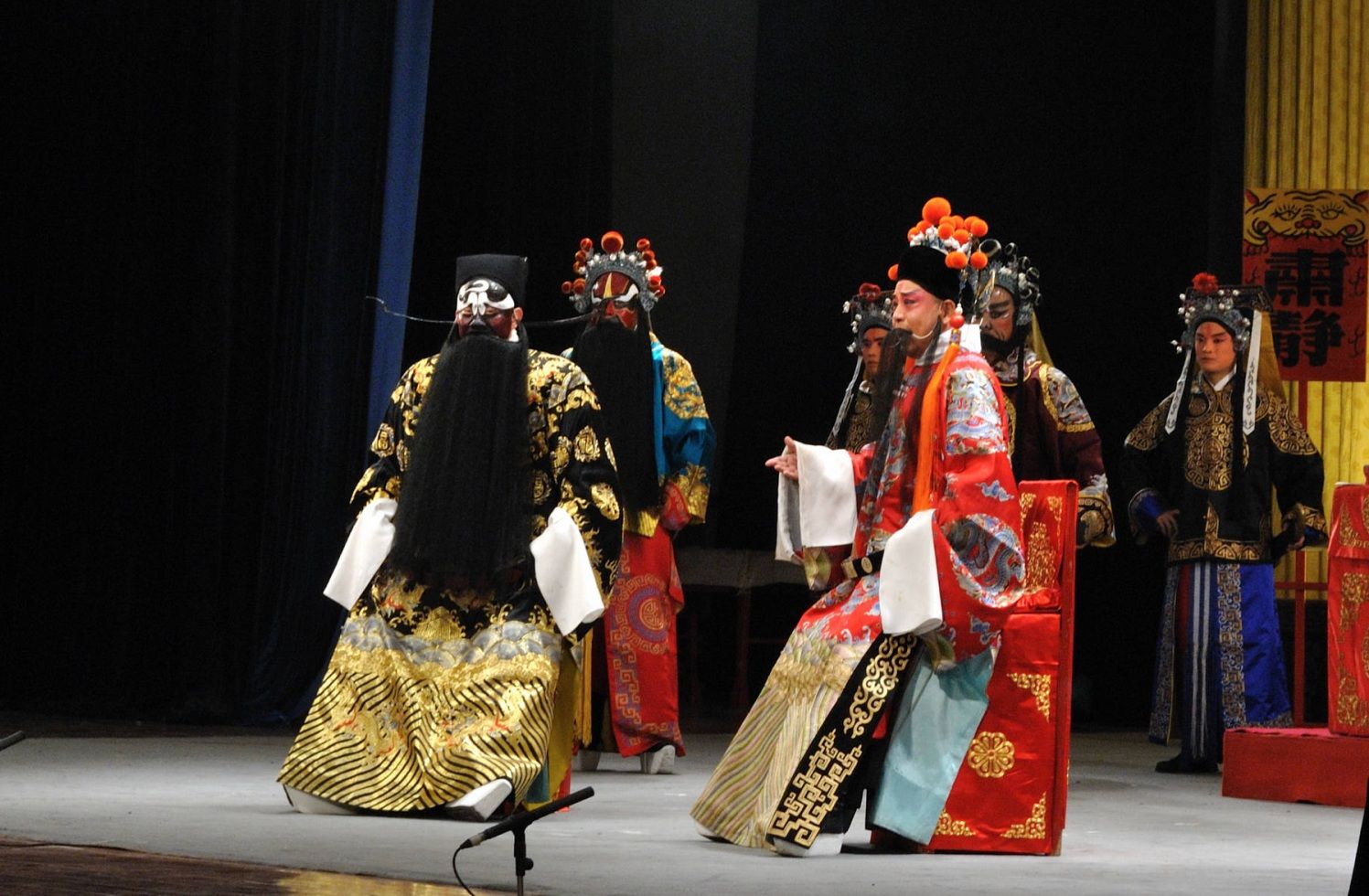

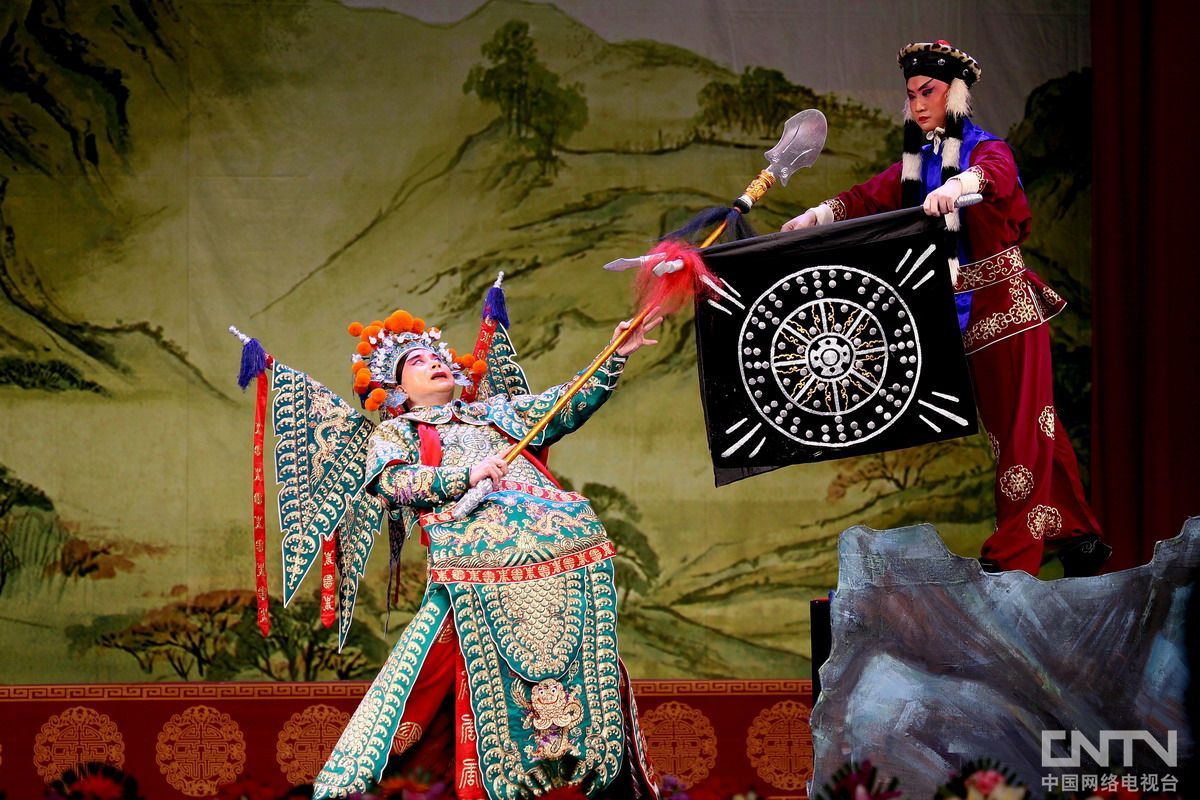


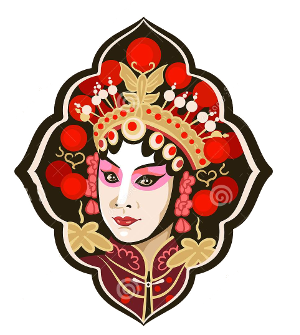

 Traditions
Traditions
 Vacation and Travel
Vacation and Travel





